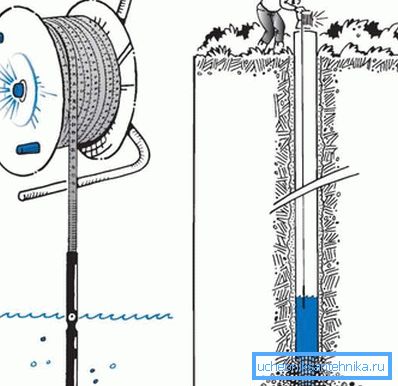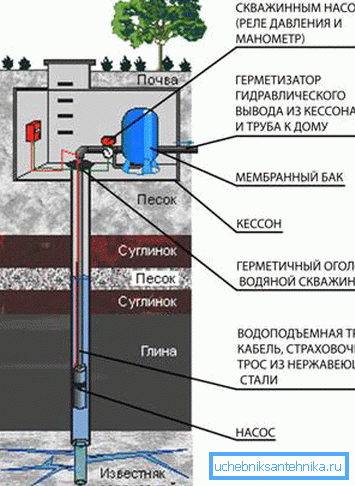How deep to lower the pump into the well: suspension
Before lowering the pump into the well, it is necessary to accurately measure the length of the cable. This is done to ensure that the device is located at a certain depth. Only if the level of placement is right, the water supply will be stable, and the pump itself will last a long time.
Below we describe how to determine the correct height of the water-lifting device in the well, and also give some tips on its installation.

Basic terms
When planning the placement of a pump in a drilled well, our main task is to place it so that it is constantly under water. To do this, you must perform simple calculations and perform several operations with the suspension system..
But first of all it is necessary to understand the main parameters that characterize the aquifer wells.
Among them, the most important for us are:
- The total depth is the distance from the top edge of the head to the bottom. Typically, depth information is reported at the time of drilling, but no one forbids us to check this figure with a load on a thin and durable cord.
Note! From the depth depends largely on the choice of the pump on the head. The deepest wells require the installation of high-pressure equipment, the price of which is very substantial.
- Static water level - the distance from the top point to the edge of the water mirror. You can determine it with a small load, lowering it to a depth before loosening the cord or the appearance of the first burst.
- The water level is dynamic - the height of the water mirror when the pump is running. This value is always less than the static level.

Note! Static and dynamic indicators of the water level may vary depending on the season and weather conditions. For the most accurate calculation, experts recommend focusing on minimum indicators.
As we noted, all these values are determined during drilling and are entered into the well passport. However, if after the completion of the drilling work, it took quite a long time, or you do not have a passport at all (sometimes it happens when recovering orphan wells), you can always take measurements yourself.

Recommendations for placement
Selecting the position of the device
So, we have determined that the main parameters that determine the installation location of the pump are static and dynamic water levels.
At the same time, experts recommend sticking to the following rules:
- The device is placed in such a way that the holes through which water is taken are at least 1 meter below the minimum dynamic level.
- It should be remembered that for pumps with different capacities, the dynamic level may differ, so that when replacing one model with another, it is worth adjusting the length of the suspension.
- To prevent turbulence during water intake from clogging up the flow part of the pump, it is placed at a distance of 1 to 3 m from the bottom of the well. Then the sand and clay will not rise, and fall into the water intake pipes.

Tip! An exception is the installation of equipment when pumping wells - in this case, the pump is placed as low as possible so that it can capture sand and clay.
- For deep artesian wells, the situation is somewhat different. Since the water level in them is usually very high, the water intake is about 2/3 of the depth - exactly where the casing ends. Below to lower the pump is not advised - there may be problems during operation, as well as a jam when trying to extract.
- Of particular difficulty is the installation of equipment in shallow wells with low water levels. Here we have to choose - either we protect the pump from a dry run, or we insure ourselves against sand getting into the flow part. Here it is necessary to turn to professionals.

At the same time, one should not think that once having correctly arranged the water-lifting device, one can forget about this question forever. The position of the pump part must be periodically monitored and adjusted. Thus, in summer, in some regions, the water level can drop quite noticeably, and therefore the pump must be lowered lower.
Correct binding
Installation instructions for the well pump are quite simple. With proper skill, you can cope with this task on your own, without involving specialists in your work.
You just need to follow the algorithm:
- To begin with, we study the well passport, determining the dynamic water level.
- If possible, we control the distance to the water mirror with a cord with a sinker.

- In accordance with the data obtained, we prepare a cable, cable and water-lifting hose of the required length. To facilitate installation, we connect the power supply cable with a hose with plastic clips every 3-4 meters.
- Instead of a cable, you can use a cord with a fivefold margin of strength. To install the device at a shallow depth (up to 10m), we mount a spring suspension from rubber harness at the end of the cable - it will dampen the vibration.

- One end of the suspension is securely fastened to the pump housing using standard lugs.
- Attach the suspension system to the winch and lower the pump into the well. At the same time, we make sure that the device case does not touch the walls, since during operation it is possible that parts are damaged with a leak.
Tip! If the gap between the walls and the body of the apparatus is very small, it is necessary to use a rubber damping ring.
- Slowly lower the pump to the selected depth, then mount the tip. Only after this it is worthwhile to start the pump in test mode.
Conclusion
After examining the design features of our well and correctly selecting the depth of the aquifers, we will be able to mount the pump with our own hands. At the same time, it is necessary to very accurately calculate the position of the water intake point, otherwise either the water-lifting device will suffer from periodic work in the “dry run” mode, or sand from the bottom will fall into it. The video in this article will help you understand the nuances of this problem.